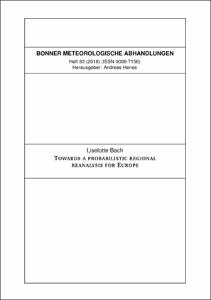Bach, Liselotte: Towards a probabilistic regional reanalysis for Europe. - Bonn, 2018. - Dissertation, Rheinische Friedrich-Wilhelms-Universität Bonn.
Online-Ausgabe in bonndoc: https://nbn-resolving.org/urn:nbn:de:hbz:5n-50184
Online-Ausgabe in bonndoc: https://nbn-resolving.org/urn:nbn:de:hbz:5n-50184
@phdthesis{handle:20.500.11811/7528,
urn: https://nbn-resolving.org/urn:nbn:de:hbz:5n-50184,
author = {{Liselotte Bach}},
title = {Towards a probabilistic regional reanalysis for Europe},
school = {Rheinische Friedrich-Wilhelms-Universität Bonn},
year = 2018,
month = jun,
volume = 83,
note = {A new development in the field of reanalyses is the incorporation of uncertainty estimation capabilities. In the course of this work, a new probabilistic regional reanalysis system for the CORDEX-EUR11 domain has been developed. It is based on the numerical weather prediction model COSMO at a 12 km grid spacing. The lateral boundary conditions of all ensemble members are provided by the global reanalysis ERA-Interim. In the basic implementation of the system, uncertainties due to observation errors are estimated. Atmospheric assimilation of conventional observations perturbed by means of random samples of observation error yields estimates of the reanalysis uncertainty conditioned to observation errors.
The data assimilation employed is a new scheme based on observation nudging that is denoted ensemble nudging. The lower boundary of the atmosphere is regularly updated by external snow depth, sea surface temperature and soil moisture analyses. One of the most important purposes of reanalyses is the estimation of so-called essential climate variables. For regional reanalyses, precipitation has been identified as one of the essential climate variables that are potentially better represented than in other climate data sets. For that reason, the representation of precipitation in the system is assessed in a pilot study. Based on two experiments, each of which extends over one month, a preliminary comparison to the global reanalysis ERA-Interim, a dynamical downscaling of the latter and the high-resolution regional reanalysis COSMO-REA6 is conducted. In a next step, the probabilistic capabilities of the reanalysis system are assessed versus the ECMWF-EPS in terms of six-hourly precipitation sums. The added value of the probabilistic regional reanalysis system motivates the current production of a 5-year long test reanalysis COSMO-EN-REA12 in the framework of the FP7-funded project Uncertainties in Ensembles of Regional Reanalyses (UERRA).
To provide an indication of how the probabilistic reanalysis system would be configured ideally for future long-term reanalyses, it is updated to a new model version of COSMO and extended by further uncertainty estimation capabilities. Now, model error can be accounted for by the method of stochastic perturbation of physical tendencies. Further, uncertainties in the lateral boundary conditions are incorporated by utilizing a global ensemble of the new numerical weather prediction model ICON. A comparative verification of screen-level temperature as second important essential climate variable and precipitation in a range of numerical experiments with different configurations of the reanalysis system indicates that the best probabilistic capabilities are achieved by accounting for as many uncertain components as possible.},
url = {https://hdl.handle.net/20.500.11811/7528}
}
urn: https://nbn-resolving.org/urn:nbn:de:hbz:5n-50184,
author = {{Liselotte Bach}},
title = {Towards a probabilistic regional reanalysis for Europe},
school = {Rheinische Friedrich-Wilhelms-Universität Bonn},
year = 2018,
month = jun,
volume = 83,
note = {A new development in the field of reanalyses is the incorporation of uncertainty estimation capabilities. In the course of this work, a new probabilistic regional reanalysis system for the CORDEX-EUR11 domain has been developed. It is based on the numerical weather prediction model COSMO at a 12 km grid spacing. The lateral boundary conditions of all ensemble members are provided by the global reanalysis ERA-Interim. In the basic implementation of the system, uncertainties due to observation errors are estimated. Atmospheric assimilation of conventional observations perturbed by means of random samples of observation error yields estimates of the reanalysis uncertainty conditioned to observation errors.
The data assimilation employed is a new scheme based on observation nudging that is denoted ensemble nudging. The lower boundary of the atmosphere is regularly updated by external snow depth, sea surface temperature and soil moisture analyses. One of the most important purposes of reanalyses is the estimation of so-called essential climate variables. For regional reanalyses, precipitation has been identified as one of the essential climate variables that are potentially better represented than in other climate data sets. For that reason, the representation of precipitation in the system is assessed in a pilot study. Based on two experiments, each of which extends over one month, a preliminary comparison to the global reanalysis ERA-Interim, a dynamical downscaling of the latter and the high-resolution regional reanalysis COSMO-REA6 is conducted. In a next step, the probabilistic capabilities of the reanalysis system are assessed versus the ECMWF-EPS in terms of six-hourly precipitation sums. The added value of the probabilistic regional reanalysis system motivates the current production of a 5-year long test reanalysis COSMO-EN-REA12 in the framework of the FP7-funded project Uncertainties in Ensembles of Regional Reanalyses (UERRA).
To provide an indication of how the probabilistic reanalysis system would be configured ideally for future long-term reanalyses, it is updated to a new model version of COSMO and extended by further uncertainty estimation capabilities. Now, model error can be accounted for by the method of stochastic perturbation of physical tendencies. Further, uncertainties in the lateral boundary conditions are incorporated by utilizing a global ensemble of the new numerical weather prediction model ICON. A comparative verification of screen-level temperature as second important essential climate variable and precipitation in a range of numerical experiments with different configurations of the reanalysis system indicates that the best probabilistic capabilities are achieved by accounting for as many uncertain components as possible.},
url = {https://hdl.handle.net/20.500.11811/7528}
}






